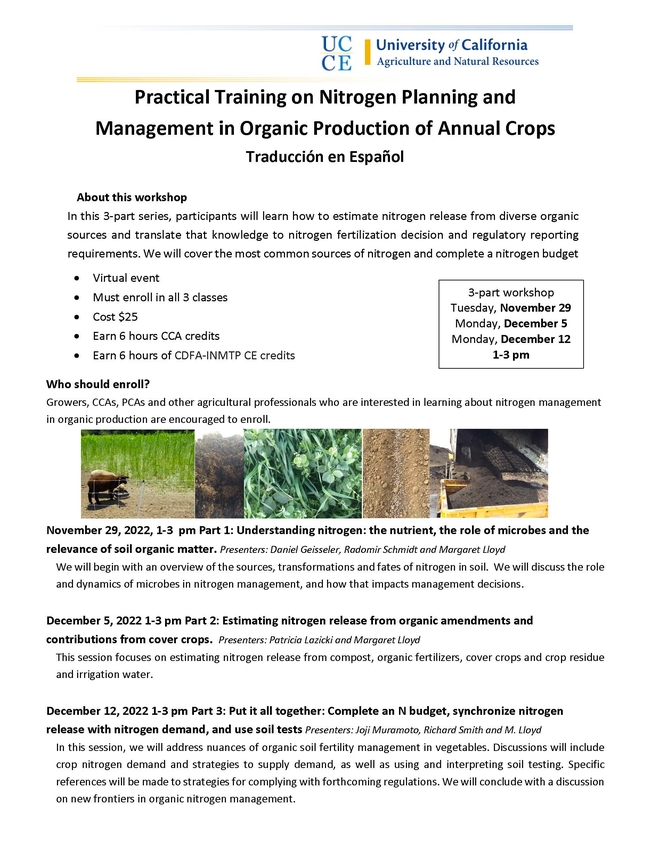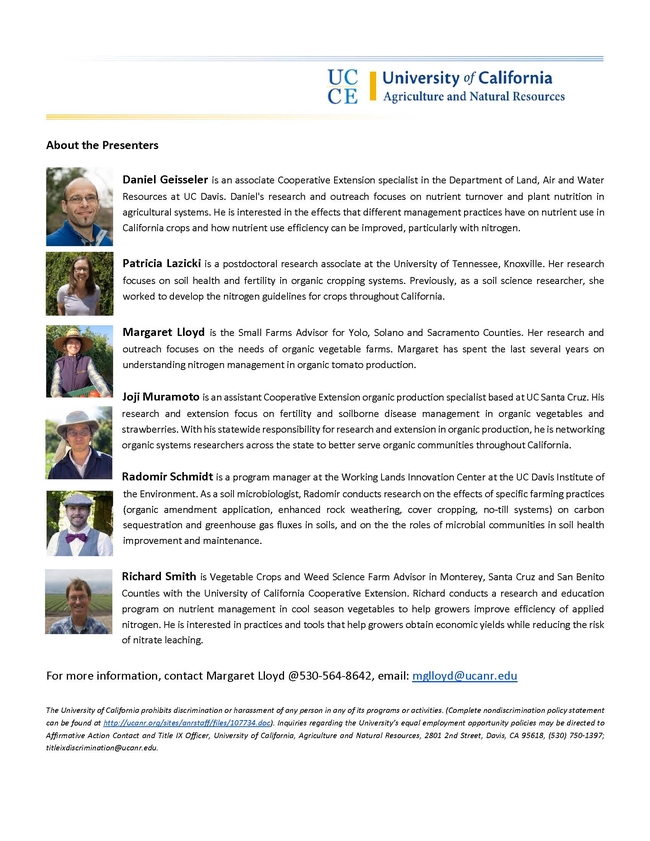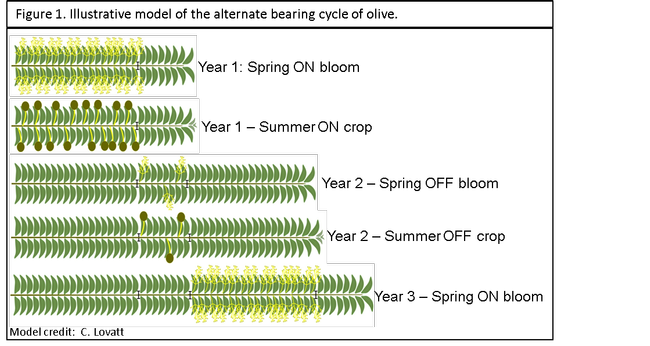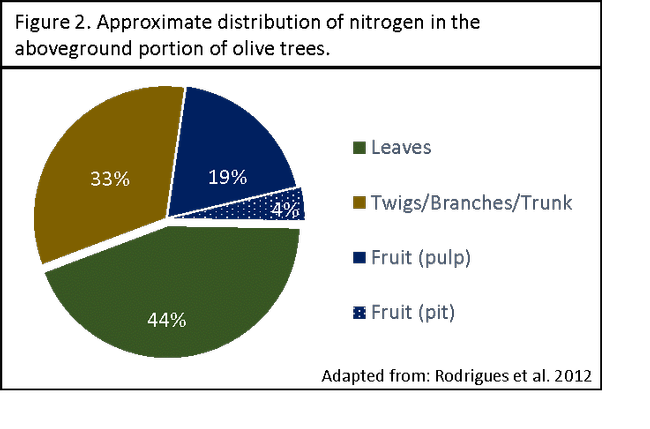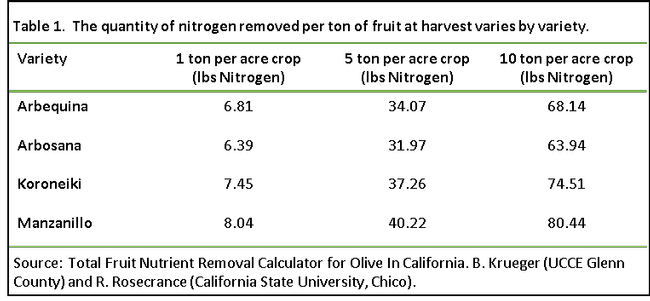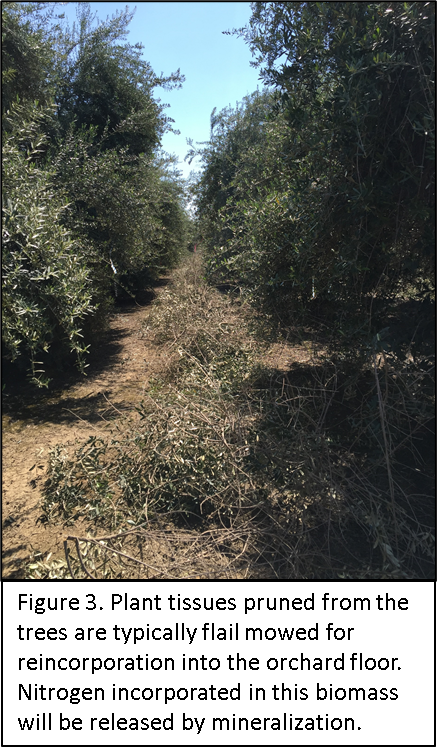
Posts Tagged: nitrogen
Managing Nitrogen Organically
Practical Training in Nitrogen Planning & Management in Organic Production of Annual Crops
BUT All Growers Could Learn from these sessions
- Virtual Event – Habrá traducción al Español
3-part Workshop
Session 1: Monday, Nov. 27th, 2023, 1-3pm
Session 2: Monday, Dec. 4th, 2023, 1-3pm
Session 3: Monday, Dec. 11th, 2023, 1-3pm
Session 4*: Monday, Dec. 18th, 2023, 1-3pm
*attendance optional
Registration
tinyurl.com/NitrogenWorkshop
- Cost: $25*
*No one will be turned away due to lack of funds.
Please contact Rob Straser (rkstraser@ucanr.edu)
- Must enroll in Session 1-3 (Session 4 optional)
- Limited to 80 participants
- CEUs in progress
- CDFA-INMTP
- CCA
About this workshop
In this 3-part series, participants will learn how to estimate nitrogen release from diverse organic sources and translate that knowledge to nitrogen fertilization plans and regulatory reporting requirements. Over the 3 sessions, we will cover the most common sources of nitrogen and complete a nitrogen budget. In session 2 and 4, participants will be able to work on and receive feedback on their own nitrogen budgets.
Who should enroll?
Growers, CCAs, PCAs and other agricultural professionals who are interested in learning about nitrogen management in organic production are encouraged to enroll.
Program agenda
Session 1: Monday, Nov. 27, 2023, 1-3pm
Understanding nitrogen: the nutrient, the role of microbes and the
relevance of soil organic matter
Presenters: Daniel Geisseler, Radomir Schmidt and Margaret Lloyd
We will begin with an overview of the sources, transformations and fates of sources of organic nitrogen in soil. Foundational to this, we'll cover the role and dynamics of microbes in nitrogen management, and how that impacts management decisions. Lastly, we'll discuss using nitrogen budgets to understand the sources and proportions of available nitrogen to meet crop demand.
Session 2: Monday, Dec. 4, 2023, 1-3pm
Estimating nitrogen release from organic amendments and contributions
from cover crops
Presenters: Patricia Lazicki and Margaret Lloyd
This session will focus on estimating nitrogen release from compost, organic fertilizers and cover crops. In addition, participants will be invited to apply the training to their own operations and receive feedback on the budget calculations during this session.
2
Nitrogen Planning & Management Workshop UC Cooperative Extension
Session 3: Monday, Dec. 11, 2023, 1-3pm
Putting it all together: Completing a nitrogen budget, synchronizing
nitrogen release with nitrogen demand, soil tests, and frontiers in nitrogen
science
Presenters: Daniel Geisseler, Joji Muramoto, Michael Cahn and Margaret Lloyd
In this session, we will address specific aspects of organic soil fertility management in warm season vegetables. Discussions will include crop nitrogen demand and strategies to supply demand, as well as using and interpreting soil testing. Specific references will be made to strategies for complying with forthcoming regulations. We will conclude with a discussion on new frontiers in organic nitrogen management.
Session 4*: Monday, Dec. 18, 2023, 1-3pm
*attendance optional
Grower Panel and Open House
In this session we will have 1-2 growers share their experience managing nitrogen on their farms. Then, we will open it up to questions, share experiences and discuss the nitrogen budget file. Attendees are encouraged to bring their own data to receive feedback.
About the Presenters
Daniel Geisseler is a Cooperative Extension specialist in the Department of Land, Air and Water Resources at UC Davis.
Daniel's research and outreach focuses on nutrient turnover and plant nutrition in agricultural systems. He is interested in the
effects that different management practices have on nutrient use in California crops and how nutrient use efficiency can be
improved, particularly with nitrogen.
Patricia Lazicki is the Vegetable Crops Advisor for Yolo, Solano, and Sacramento Counties, working mainly in tomatoes.
Her research interests include soil health, and nutrient management and fertility in organic annual cropping systems.
Margaret Lloyd is the Organic Agriculture and Small Farms Advisor for Yolo, Solano and Sacramento Counties. She runs an
active research and outreach program focused on nutrient management and pest management for organic vegetable farms.
Joji Muramoto is an Assistant Cooperative Extension organic production specialist at UC Santa Cruz. His research and
extension focus on nitrogen and soilborne disease management in organic cropping systems across the state
.
Radomir Schmidt is a program manager at the Working Lands Innovation Center at the UC Davis Institute of the Environment.
As a soil microbiologist, Radomir conducts research on the effects of specific farming practices (organic amendment
application, enhanced rock weathering, cover cropping, no-till systems) on carbon sequestration and greenhouse gas fluxes in
soils, and on the roles of microbial communities in soil health improvement and maintenance
.
Michael Cahn is an irrigation and water resources Farm Advisor for UC Cooperative Extension in Monterey County. His
research and extension program focuses on irrigation efficiency, nutrient use of crops, and protecting water quality. He led
the development of CropManage, an online decision support tool for irrigation and nutrient management.
For more information, contact Rob Straser: (rkstraser@ucanr.edu) or Margaret Lloyd (530-564-8642, mglloyd@ucanr.edu).
The University of California prohibits discrimination or harassment of any person in any of its programs or activities. (Complete nondiscrimination policy statement
can be found at http://ucanr.org/sites/anrstaff/files/107734.doc). Inquiries regarding the University's equal employment opportunity policies may be directed to
Affirmative Action Contact and Title IX Officer, University of California, Agriculture and Natural Resources, 2801 2nd Street, Davis, CA 95618, (530) 750-1397

Nitrogen workshop flier
Nitrogen Training for Organic Systems
N? or Nitrogen?
Are you interested in learning more about Nitrogen Management?
Are you ready for the big time?
Are you a Certified Crop Adviser seeking Continuing Education Units and/or preparing for the new California Nitrogen Specialty Exam?
Has your grower clientele asked if you are eligible to sign off on a Nitrogen Management Plan?
Registration for the brand new UC Nitrogen Management course is now open at:
http://ucanr.edu/NitrogenCourse
The UC Nitrogen Course is taught online through a video series delivered by UC Researchers and Extension Specialists. Each module is eligible for Certified Crop Adviser (CCA) continuing education units (CEUs).
The course is open to anyone interested in learning more about N management in California. The curriculum addresses all the learning objectives set forth by the American Society of Agronomy (ASA) for the new California Nitrogen Management Specialty Exam.
The 7-part video series starts Monday May 9th.
Register at http://ucanr.edu/NitrogenCourse
You may join the course at any time up until July 31st.
For more information contact Sat Darshan Khalsa at sdskhalsa@ucdavis.edu or visit the FAQ page.
map of groundwater management areas of Ventura county
Learning the Ways of Nitrogen
UC Nitrogen Management Course Online Open to All Interested Parties,
starting November 8th
Are you interested in learning more about Nitrogen Management? Are you a Certified Crop Advisor seeking Continuing Education Units and/or preparing for the new California Nitrogen Specialty Exam? Have your grower clientele asked you if you are eligible to sign off on a Nitrogen Management Plan? Registration for the UC Nitrogen Management course is now open at http://ucanr.edu/NitrogenCourse. The UC Nitrogen Course is taught online through a video series delivered by UC Researchers and Extension Specialists. Each module is eligible for Certified Crop Advisor (CCA) continuing education units (CEUs). The course is open to anyone interested in learning more about N management in California.
The curriculum addresses all the learning objectives set forth by the American Society of Agronomy (ASA) for the new California Nitrogen Management Specialty Exam. The video series opens next week November 8, 2021.
Register at http://ucanr.edu/nitrogencourse/
You may join the course at any time up until December 31, 2021
For more information contact Sat Darshan Khalsa at sdskhalsa@ucdavis.edu or 707-205-7007 or visit their FAQ page [https://ucanr.edu/sites/nitrogencourse/FAQ/].
Image: Citrus N uptake varies from country to country, Geisseler

Citrus N uptake
Fertilizing Olives
Developing a nitrogen fertilizer plan for olive orchards
Elizabeth J. Fichtner, Farm Advisor, UCCE Kings and Tulare Counties
Nitrogen management plans (NMP) for California olive orchards are essential for the Irrigated Lands Regulatory Program and can increase net return. A good NMP has the potential to increase yield, improve oil quality and mitigate biotic and abiotic stresses while reducing nitrogen losses from the orchard.
Olives differ from other orchard crops in California in that they are both evergreen and alternate bearing. Individual leaves may persist on the tree for two to three years. Leaf abscission is somewhat seasonal, with most leaf drop occurring in late Spring. Rapid shoot expansion occurs on non-bearing branches during the hottest part of the summer (July-August) on ‘Manzanillo' olives in California. The fruit on bearing branches limits current season vegetative growth. Olives bear fruit on the prior year's growth, and the alternate bearing cycle is characterized by extensive vegetative growth in one year followed by reproductive growth the following year (Figure 1). With bloom occurring in late April to mid-May, fruit set can be estimated in early July, allowing for consideration of crop load while interpreting foliar nutritional analysis in late July-early August.
Critical Nitrogen Values. Foliar nitrogen content in July/August should range from approximately 1.3-1.7% to maintain adequate plant health. The symptoms of nitrogen deficiency manifest when foliar nitrogen content drops to 1.1% nitrogen. As leaves become increasingly nitrogen deficient, foliar chlorosis progresses from yellow/green to yellow. Leaf abscission is common at nitrogen levels below 0.9%. Nitrogen deficiency in olive is associated with a reduced number of flowers per inflorescence, low fruit set, and reduced yield.
Excess nitrogen (>1.7%) adversely affects oil quality. Oil with low polyphenol concentration is associated with orchards exhibiting excess nitrogen fertility. Since polyphenols are the main antioxidant in olive oil, reduced polyphenol levels are associated with reduced oxidative stability.
Nitrogen content may impact orchard susceptibility to biotic and abiotic stresses. For example, while excess nitrogen content has been associated with increased tolerance to frost prior to dormancy, in spring (post-dormancy) it is associated with sensitivity to low temperatures. High nitrogen content has also been associated with increased susceptibility to peacock spot, a foliar fungal disease on olive.
Foliar Sampling for Nitrogen Analysis. By convention, foliar nutrient analysis is conducted in late July-early August in California. Fully-expanded leaves are collected from the middle to basal region of the current year's growth at a height of about 5-8 feet from the ground. To capture a general estimate of the nitrogen status of the orchard, samples should be taken from 15-30 trees, with approximately 5-8 leaf samples collected per tree. Leaves for analysis should only be collected from non-bearing branches. Growers may find it beneficial to make note of the ON and OFF status in the historical records of each block. The orchard bearing status, combined with anticipated yield and foliar analysis will guide decisions for nitrogen applications the following year.
Distribution of nitrogen in the olive tree. Over 75% of the aboveground nitrogen in the olive tree is incorporated in the vegetative biomass (Figure 2). The twigs, secondary branches, main branches, and trunk account for approximately 33% of aboveground nitrogen (Figure 2). Twenty-three percent of the aboveground nitrogen is harbored in the fruit, with the majority in the pulp (19%) (Figure 2). Fruit is only an important nitrogen sink during the initial phase of growth. As fruit size increases, the N concentration decreases due to dilution.
Estimation of nitrogen removed from the orchard. The easiest component of orchard nitrogen loss to estimate is the nitrogen in the harvested fruit. A ton of harvested olives removes approximately 6-8 lbs of nitrogen from the orchard. The quantity of nitrogen in the fruit varies slightly between olive varieties (Table 1). Growers can use the Fruit Removal Nutrient Calculator for Olive on the California State University, Chico (CSU Chico) website to gain estimates of N removal by the three oil varieties (Arbequina, Arbosana, and Koroneiki), and the Manzanillo table olive. This tool was developed by Dr. Richard Rosecrance (Professor, CSU Chico) and Bill Krueger (Farm Advisor, UCCE). To access the Fruit Removal Nutrient Calculator for Olive, visit the following URL:
http://rrosecrance.yourweb.csuchico.edu/Model/OliveCalculator/OliveCalculator.html
Pruning may generate a second component of nitrogen loss from orchards. The best practice to mitigate nitrogen loss from pruning is to reincorporate the pruned material into the orchard floor by flail mowing. The nitrogen in this organic material will gradually become available to the trees through mineralization.
In mature orchards, the wood removed by annually pruning is approximately equal to the annual vegetative growth. Consequently, the input and removal of nitrogen in vegetative growth is cyclic and almost equal in mature orchards. In young orchards, nitrogen inputs are utilized to support vegetative growth and little nitrogen is removed from the orchard in prunings or crop. During this time nitrogen must be supplied to meet the demand to support vegetative growth. It is estimated that approximately 2.5 lbs nitrogen is required to produce 1,000 lbs. fresh weight of tree growth.
Nitrogen Use Efficiency. Not all the nitrogen supplied to the orchard from fertilizer and other inputs (ie. organic matter, irrigation water) is utilized for tree growth and crop production. A fraction of nitrogen is lost from the orchard ecosystem through processes such as runoff, leaching, and denitrification. Efficiency varies among orchards, with some orchard systems exhibiting higher nitrogen utilization rates than others. The efficiency generally varies from 60% - 90%. Higher values denote more efficient use of nitrogen inputs. To estimate the amount of nitrogen to supply an orchard, the demand is divided by the estimated efficiency. For example, if nitrogen demand is 50 lbs. per acre and efficiency is estimated at 0.8, then 62.5 lbs. of nitrogen per acre should be applied.
Summary. Nitrogen management plans are site-specific and designed to meet orchard and crop demand while reducing environmental losses. Nitrogen utilization is never 100% efficient. Nitrogen use efficiency can be maximized by minimizing losses from irrigation and fertilization practices while utilizing foliar analysis and knowledge of alternate bearing status to fine-tune applications.
Select References:
Fernández-Escobar, et al. 2011. Scientia Horticulturae 127:452–454.
Hartman, H.T. 1958. Cal Ag. Pgs 6-10.
Rodrigues, M.A. et al. 2012. Scientia Horticulturae 142:205-211.

